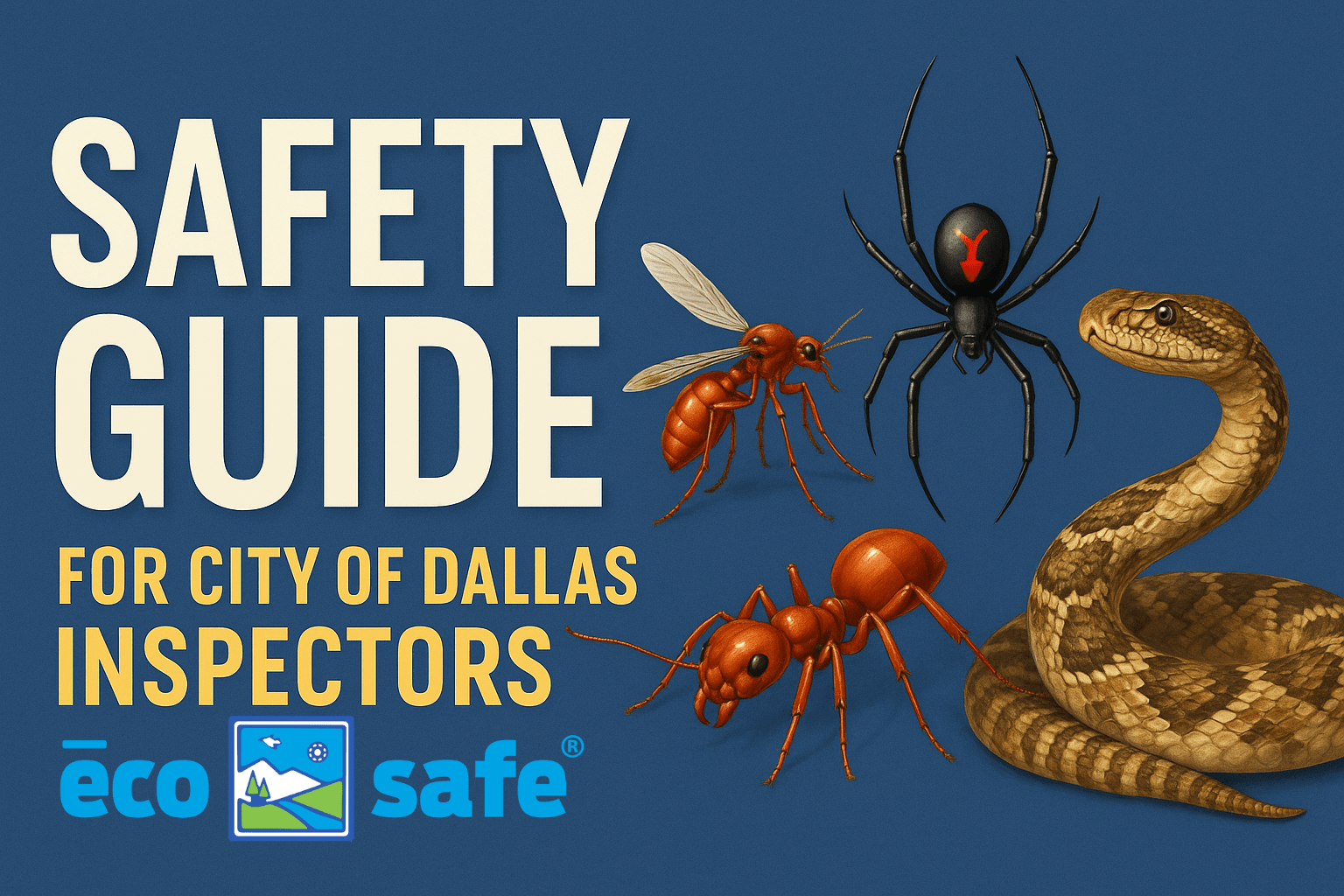Inspector Safety Guide: Dangerous Pests of North Texas
Prepared for City of Dallas Field Inspectors
Provided by Eco-Safe Pest Control | Call/Text: 214-358-5201
🦟 Mosquito
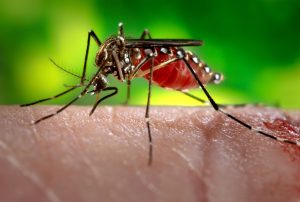
Mosquito
Scientific Name: Culicidae family
Size: 3–6 mm | Color: Gray to brown with possible white stripes
Biology & Behavior
Only females bite, feeding on blood to produce eggs. They breed in stagnant water and are active at dawn, dusk, or all day depending on species.
Where Inspectors Encounter Them
- Standing water near buildings, construction sites, or drains
- Shaded brush or tall grass areas
Risks
Vectors of West Nile, Zika, and Encephalitis. Bites cause irritation or infection.
Safety Tips
- ✅ Use an effective repellent
- ✅ Wear long sleeves and inspect for water pooling
- ❌ Avoid dusk/dawn visits without PPE
🦟 Fun Fact
Mosquitoes are attracted to CO₂ and body heat from over 100 feet away.
🐜 Fire Ant
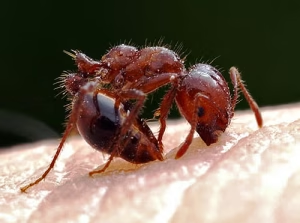
Fire Ant
Scientific Name: Solenopsis invicta
Size: 2–6 mm | Color: Reddish-brown with darker abdomen
Biology & Behavior
Fire ants live in large mounds and are very aggressive when their nest is disturbed.
Where Inspectors Encounter Them
- Soil near sidewalks, equipment boxes, or playgrounds
Risks
Stings cause painful welts and possible allergic reactions.
Safety Tips
- ✅ Check grassy areas before kneeling or placing gear
- ✅ Tuck pants into boots
- ❌ Don’t slap ants off, brush or rinse them quickly
🐜 Fun Fact
Fire ants form living rafts in floods, with the queen in the center!
🐜 Harvester Ants

Scientific Name: Pogonomyrmex barbatus
Size: 5–7 mm | Color: Reddish-brown with large head and powerful mandibles
Biology & Behavior
Harvester ants are ground-nesting insects that forage for seeds and are known for clearing large, bare patches around their nest entrances. They are not typically aggressive unless their nest is disturbed — but when they do sting, it’s extremely painful and long-lasting. They do not swarm but will pursue a perceived threat.
Where Inspectors Encounter Them
- Open grassy fields, parks, and playgrounds
- Sidewalk cracks or near utility boxes
- Near curbs, medians, and poorly landscaped lots
Risks
Stings from harvester ants are among the most painful of North American insects and can cause swelling, itching, and in rare cases, allergic reactions. Unlike fire ants, they bite and sting once, but their venom is potent.
Safety Tips
- ✅ Watch your step when walking in dry, open areas
- ✅ Avoid disturbing cleared circles of bare soil, a sign of their nest
- ❌ Don’t kneel, lean, or place equipment near active mounds
🧠 Fun Fact
Harvester ants “farm” seed caches underground and are considered vital to native ecosystems, but still pack a sting powerful enough to make headlines!
🕷️ Black Widow Spider
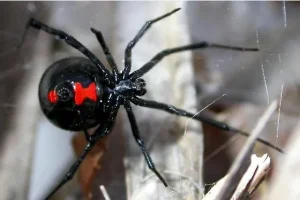
Black Widow
Scientific Name: Latrodectus mactans
Size: Up to 1.5 inches | Color: Black with red hourglass
Biology & Behavior
Hides in crevices or boxes. Bites occur when accidentally touched or trapped.
Where Inspectors Encounter Them
- Inside valve boxes, sheds, under benches, portable restrooms
Risks
Bites can cause cramps, nausea, and sweating, especially in sensitive individuals.
Safety Tips
- ✅ Wear gloves when reaching into dark areas
- ✅ Tap meter lids or boxes before opening
🕷️ Fun Fact
Black widow silk is incredibly strong, stronger than steel by weight!
🕷️ Brown Recluse Spider
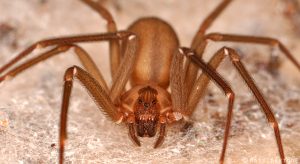 Brown Recluse with violin marking on its back.
Brown Recluse with violin marking on its back.Scientific Name: Loxosceles reclusa
Size: 6–20 mm | Color: Tan with violin-shaped mark
Biology & Behavior
Shy, nocturnal spiders that bite when trapped in clothing, gloves, or boots. They prefer dry, undisturbed spaces. Nocturnal and reclusive, hides in clutter and bites when pressed against skin.
Where Inspectors Encounter Them
- Inside meter boxes, storage sheds, garages, or wall voids
- Behind stored items in sheds or closets
- Under insulation, unused furniture, or cardboard boxes
Risks
Bites can become necrotic or lead to serious infection. May require medical attention.
Safety Tips
- ✅ Shake out boots/gloves before wear
- ✅ Don’t reach blindly into boxes or crevices
- ❌ Never assume all small spiders are harmless
🕷️ Fun Facts
- Brown Recluses can live 6–12 months without food or water!
- Brown Recluses have 6 eyes, unlike most spiders that have 8!
🦂 Striped Bark Scorpion
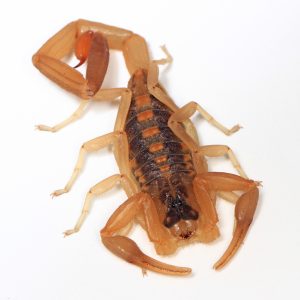 Texas’s most common scorpion species, stings hurt!
Texas’s most common scorpion species, stings hurt!Scientific Name: Centruroides vittatus
Size: 2–3 in | Color: Tan-yellow with two dark dorsal stripes
Biology & Behavior
Hides under rocks, logs, and debris during the day. Emerges at night. Venomous but rarely dangerous unless allergic.
Where Inspectors Encounter Them
- Under bricks, lids, pipes, valve boxes, and mulch
- Meter boxes, valve covers, under landscaping stones
- Woodpiles and inside exterior wall gaps
Risks
Stings cause local pain, swelling, and tingling. Children and allergic individuals most at risk.
Safety Tips
- ✅ Use gloves when lifting anything on the ground
- ✅ Store shoes and gloves off the ground when possible
🦂 Fun Fact
Scorpions glow neon green under UV light!
🕷️ Tick
Scientific Name: Ixodidae (Deer tick, dog tick, Lone Star tick)
Size: 2–5 mm | Color: Brown to reddish
Biology & Behavior
Ticks wait in tall grass or brush, then latch onto people or animals. Feed for hours or days and transmit Lyme and other illnesses.
Where Inspectors Encounter Them
- Tall grass, brush, or shaded woods
- Near wildlife dens or trails
Risks
Transmit Lyme, Ehrlichiosis, and more. Improper removal can cause skin irritation or infection.
Safety Tips
- ✅ Perform daily tick checks after wooded site visits
- ✅ Use permethrin-treated boots and pants
- ❌ Do not twist or squeeze ticks, use tweezers
🧠 Fun Fact
Ticks can detect breath, heat, and motion to locate a host!
🔬 Chigger
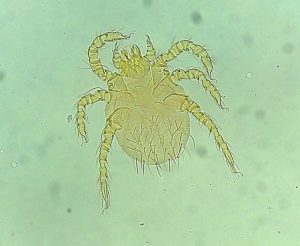 Chigger under microscope
Chigger under microscopeScientific Name: Trombiculidae (larval mite)
Size: < 0.4 mm | Color: Red-orange (microscopic)
Biology & Behavior
Larvae attach to skin, inject enzymes to digest cells, then drop off after feeding.
Where Inspectors Encounter Them
- Overgrown fields, shady park trails, tall weeds
- Creek beds, vacant lots, or brushy zones
Risks
Intense itching and welts from enzyme reaction. Scratching may cause infection.
Safety Tips
- ✅ Shower and scrub skin after outdoor fieldwork
- ✅ Wear high socks and insect repellent on legs
- ❌ Don’t sit or kneel in overgrown areas unprotected
🧠 Fun Fact
They don’t burrow into skin, that’s a myth!
🐝 Yellowjackets & Paper Wasps
Scientific Name: Vespula spp. and Polistes spp.
Size: 12–20 mm | Color: Black and yellow (yellowjacket), brown with orange (paper wasp)
Biology & Behavior
Aggressively defend nests, especially late summer. Attracted to food and sugary drinks.
Where Inspectors Encounter Them
- Eaves, meter boxes, light fixtures
- Bushes, trash cans, or crevices in outdoor structures
Risks
Stings are painful and may be dangerous to allergic individuals. Can sting multiple times.
Safety Tips
- ✅ Observe overhead spaces before stepping into areas
- ✅ Carry epinephrine if allergic
- ❌ Don’t swat, calmly back away
🧠 Fun Fact
Paper wasps chew wood fibers to build their umbrella-shaped nests!
🐍 Copperhead
Scientific Name: Agkistrodon contortrix
Size: 2–3 feet | Color: Coppery with hourglass-shaped bands
Biology & Behavior
Venomous. Camouflages well in leaves or mulch. Bites when stepped on or provoked.
Where Inspectors Encounter Them
- Wooded parks, landscaping beds, near creeks or drainage zones
Risks
Bites can cause swelling, pain, and tissue damage. Fatalities are rare but possible.
Safety Tips
- ✅ Watch step in mulched or leaf-covered ground
- ✅ Never reach into brush without seeing your hand
- ❌ Don’t try to move or kill the snake
🧠 Fun Fact
Copperheads may freeze instead of fleeing — making them easy to step on by accident!
🐀 Rodents & Urban Wildlife
Scientific Name: Rattus spp., Procyon lotor, Mephitis mephitis, Canis latrans
Size: Varies | Color: Brown/gray rats, striped skunks, banded raccoons, gray coyotes
Biology & Behavior
Forage at night, den in crawlspaces or attics, and can be defensive when cornered.
Where Inspectors Encounter Them
- Dumpster zones, alleys, under decks or trailers
- Behind sheds, in overgrown lots
Risks
Bites, scratches, and zoonotic disease like leptospirosis, rabies, or fleas.
Safety Tips
- ✅ Never corner wildlife — back away slowly
- ✅ Secure food waste and report dens
- ❌ Don’t try to trap or relocate animals yourself
🧠 Fun Fact
Coyotes now live in nearly every major U.S. city, including downtown Dallas!
🐍 Coral Snake
Scientific Name: Micrurus tener
Size: 18–24 inches | Color: Black, red, and yellow bands
Biology & Behavior
Highly venomous but reclusive. Bites are rare and occur when handled or stepped on.
Where Inspectors Encounter Them
- Under rocks or logs in wooded and sandy areas
- Dry brush, debris piles, or near foundations
Risks
Neurotoxic venom can cause respiratory failure if untreated.
Safety Tips
- ✅ Avoid picking up snakes, even small or ‘colorful’ ones
- ✅ Use tools to lift debris
- ❌ Don’t rely on memory — ID by professionals
🧠 Fun Fact
Famous rhyme helps identify them: ‘Red touch yellow, kill a fellow. Red touch black, friend of Jack.’
🐍 Western Diamondback Rattlesnake

Scientific Name: Crotalus atrox
Size: 3–5 feet | Color: Gray/tan with diamond-shaped patterns
Biology & Behavior
Uses rattle as warning. Defensive, not aggressive. Active in spring/summer.
Where Inspectors Encounter Them
- Dry, rocky, or grassy areas — especially rural job sites
- Along fence lines, behind HVAC or sheds
Risks
Hemotoxic venom causes extreme pain, swelling, and tissue damage.
Safety Tips
- ✅ Back away if you hear a rattle — don’t run
- ✅ Wear boots and long pants in brush
- ❌ Never approach or attempt to kill
🧠 Fun Fact
Can strike one-third to half their body length in an instant!
🐍 Cottonmouth (Water Moccasin)

Scientific Name: Agkistrodon piscivorus
Size: 2–4 feet | Color: Dark olive or brown with pale mouth interior
Biology & Behavior
Semi-aquatic. Will stand ground and gape mouth in defense. Venomous.
Where Inspectors Encounter Them
- Near ponds, drainage ditches, culverts
- Creek beds or flooded areas
Risks
Venomous bites may lead to infection, swelling, and tissue destruction.
Safety Tips
- ✅ Watch footing near water sources
- ✅ Use walking stick in tall vegetation
- ❌ Don’t enter murky water blindly
🧠 Fun Fact
Their famous open-mouth display warns predators before striking!
🐢 Snapping Turtle

Scientific Name: Chelydra serpentina
Size: 10–18 inches (shell), up to 30 lbs | Color: Dark brown/gray shell, long tail, hooked beak
Biology & Behavior
Aggressive on land. Strong bite. Found crossing roads or near muddy ponds.
Where Inspectors Encounter Them
- Stormwater ponds, creeks, wetlands, and retention basins
Risks
Powerful jaws can cause serious lacerations or finger injury.
Safety Tips
- ✅ Never try to pick one up — even small ones
- ✅ Alert animal control if one is in a public walkway
- ❌ Don’t attempt to ‘rescue’ it from roads
🧠 Fun Fact
Snapping turtles can stretch their neck halfway around their body to snap!
Need help identifying a pest or wildlife issue?
📸 Snap a photo and contact Eco-Safe Pest Control — proudly supporting City of Dallas safety education.
Call or Text: 214-358-5201
Or visit us online:

Scan to visit website


